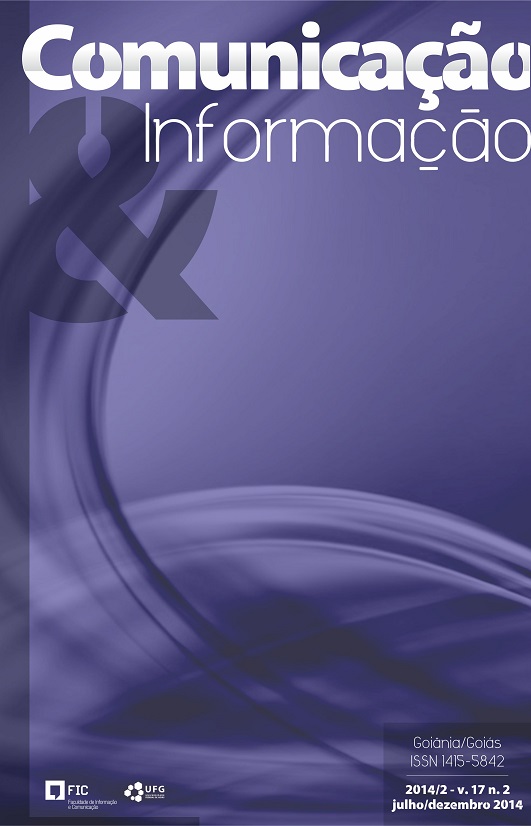Analysis of the construction of the concept Choreographic Object through the methodological triangulation: mutability, transferability
DOI:
https://doi.org/10.5216/32052Keywords:
Choreographic Object. Grounded Analysis. Methodological Triangulation.Abstract
The goal of this article is the presentation of an uncommon approach in the world of performing arts. Starting from the William Forsythe's concept of Choreographic Object (FORSYTHE, 2008), originally bound to dance, we aimed the clarification and exploration of both the concept itself and its application in areas such as the performing arts, production practices and the projection of space. Being integrated into the production crew of Scattered Crowd allowed the conjugation of methods of accessing the main performers of this play: William Forsythe himself and 10 elements of the crew who contributed to this installation. The interviews were conjugated with meaning and experience exploration techniques such as resorting to visual and graphic objects (poster) and video objects. The conjugation of the prospectives granted through four distinct qualitative methodologies constitutes the conclusion of this article. The completion of the triangulation of these various approaches allows you to understand the concept of "choreographic object" as an object of convergence. This conclusion is derived from the ongoing research. The convergence that "choreographic object" holds seems to materialize in the effect that requires and in the way it affects who attends it, the spectator.
Downloads
References
DENZIN, K. The research act in sociology. Chicago: Aldine, 1970.
FONTE, Carla. Investigar narrativas e significados: a Grounded Analysis como metodologia de referência. Revista da Faculdade de Ciências Humanas e Sociais, Porto, v. [s.i.], n. 2, p. 290-297, 2005.
FORSYTHE, W. Choreographic objects. In: BIRNBAUM, D.; FORSYTHE, W.; WEISBECK, M. Suspense. Alemanha, 2008.
GABLIK, S. The object lesson. In:Magritte, Londres: Thames and Hudson, 1970. p. 102-125.
MEDEIROS, Ana Margarida Marques de Macedo Guimarães. Análise do campo coreográfico contemporâneo: a coreografia enquanto proposta projectual de espaço. 2014. Tese (Doutorado) - Curso de Motricidade Humana, Faculdade de Motricidade Humana, Universidade de Lisboa, Lisboa, 2014.
MEDEIROS, A.; TEIXEIRA, Z. Scattered crowd: perspectivas convergentes na análise de um objecto coreográfico. In: CONGRESSO IBEROAMERICANO EM INVESTIGAÇÃO QUALITATIVA, 3., Badajoz. Anais... [s.n.],2014. p.246-251.
SEALE, Clive. Quality in Qualitative Research.Qualitative inquiry, London, v. 5, n. 4, p.465-478, nov. 1999.
STRAUSS, A; CORBIN, J. Pesquisa qualitativa:técnicas e procedimentos para o desenvolvimento da teoria fundamentada. Porto Alegre: Artmed, 2008.
Published
How to Cite
Issue
Section
License
Os autores dos trabalhos publicados na revista Comunicação e Informação retêm os direitos autorais sem restrições e concedem à revista o direito de primeira publicação, com o trabalho simultâneo licenciado sob a Licença Creative Commons Atribuição-NãoComercial que permite o compartilhamento do trabalho para fins não comerciais com reconhecimento da autoria e o privilégio de publicação primeiramente por esta revista. Caso o texto venha a ser publicado posteriormente em outro veículo, solicita-se aos autores informar que o mesmo foi originalmente publicado como artigo na revista Perspectiva, bem como citar as referências bibliográficas completas dessa publicação.
Os direitos autorais dos artigos pertencem aos autores e o conteúdo dos artigos assinados é de responsabilidade exclusiva dos autores.
A revista se reserva o direito de efetuar, nos originais, alterações de ordem normativa, ortográfica e gramatical, com o intuito de manter o padrão culto da língua, respeitando, porém, o estilo dos autores.
A revista também se reserva o direito de traduzir o artigo, no todo ou em parte, para o inglês ou para o português, dependendo do idioma em que o artigo tenha sido escrito originalmente.



